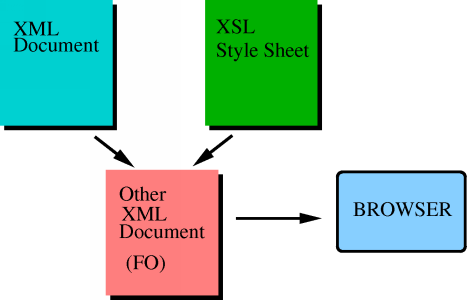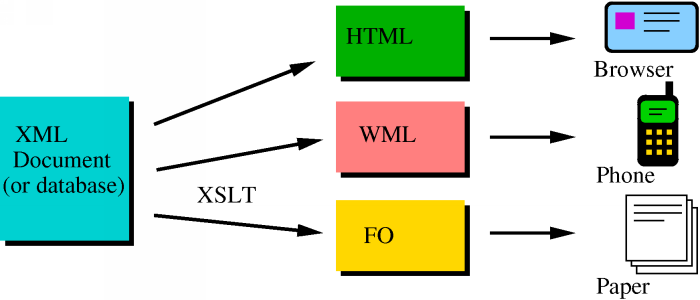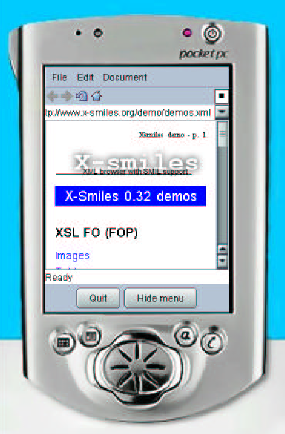
Preparation:
Page 2002
7 February 2002
http://www.w3.org/People/maxf/talks/2002-02-XSL/talk.pdf
HTML is the language of the Web: text with a set of tags to mark headers, paragraphs, etc.
<html> <h1>Title of the document</h1> <p>This is the <i>text</i> of the document</p> </html>
h1: level 1 heading (title)p: paragraphi: italics, etc.XML generalises HTML: one can define a language with any tag.
<conference> <name>Page2002</name> <date day="6-8" month="2" year="2002"/> <location>Ikebukuro</location> <abstract>This conference is about...</abstract> </conference>
In order to specify how to display the document (on paper, on the Web, etc.) it is necessary to apply style to it.
Style sheets are useful for:
Two ways to create style sheets: CSS and XSL
Example: press release Show XSL Press release page, and effect of applying user style sheet.
CSS uses a simple syntax:
body {
background-color: #ddd;
font-size: 200%;
}
a { color: green; }
h1 { color: red; }
People concerned with styling needed more:
XSL was designed to solve that. But it became much more...
Whereas CSS does this:

XSL is designed to operate as:

FO is an XML vocabulary, with presentation semantics. It defines:
<block>, <inline>,
<page-sequence>, <footnote><block text-indent="30pt" writing-mode="rl-tb">
A stylesheet is a set of templates:
<xsl:template match="body">
<page-sequence background-color="#ddd"
font-size="200%">
<xsl:apply-templates/>
</page-sequence>
</xsl:template>
But there are many more constructs that CSS rules do not have, like programming language statements: loops, conditions, etc. Stylesheets can become quite complex.
The XSL spec is split to reflect this process:
The Great Idea was to make the XSL transformations more general: anyXML-to-anyOtherXML and to make it to a separate specification: XSLT.
XSLideMaker
This set of slides was generated using XSL.
Go through XSL source showing simple templates, e.g. how the h1[class='title'] is mapped to <block xsl:use-attribute-sets...>...</block>
This shows a way to use XSL "off-line", without necessarily publishing them on the Web

With XSLT, it is possible to use XSL for publishing any kind of XML data to different sorts of devices (computers, phones, PDAs) that can display one type of XML presentation language (HTML, WML, FO). Several scenarios exist for performing the transformation: pre-generation, on-demand transformation and browser-side.
From one XML source, a set of stylesheets generate documents in various formats at different URLs:
http://www.example.org/news.html http://www.example.org/news.svg http://www.example.org/news.wml
Benefits:
http://www.example.org/news-big.html
Example: The XSL page at W3C
The XHTML stylesheet performs complex operations: grouping, sorting, etc.
Drawback of the static approach: that many useless pages could be generated. Also, different URL for version.
If client specifies a way to send its preferences, the server can generate the correct version as asked.
Accept: application/svg+xhtml GET http://www.w3.org/news
Advantages:
http://www.w3.org/news)Drawbacks:
From a source in XSP (eXtensible Server Pages)
<xsp:page
result-ns="http://www.dummy.org/SimpleHomepageDTD"
language="java">
<xsp:structure>
<xsp:include>java.lang.*</xsp:include>
</xsp:structure>
<xsp:logic>
private static int counter = 0;
private synchronized int currentCount() {
return ++counter;
}
</xsp:logic>
<xsp:content>
<page>
<title>A Sample XSP Page</title>
<p>
Hi, I've been hit
<xsp:expr>currentCount()</xsp:expr>
times.
</p>
</page>
</xsp:content>
</xsp:page>
located at a given anonymous URL (http://example.org/news), and a configuration file such as
<map:serializer name="html" mime-type="text/html"
src="org.apache.cocoon.serialization.HTMLSerializer">
<doctype-public>-//W3C//DTD HTML 4.0 Transitional//EN</doctype-public>
<doctype-system>http://www.w3.org/TR/REC-html40/loose.dtd</doctype-system>
<omit-xml-declaration>true</omit-xml-declaration>
<encoding>UTF-8</encoding>
<indent>1</indent>
</map:serializer>
<map:serializer name="wap" mime-type="text/vnd.wap.wml"
src="org.apache.cocoon.serialization.XMLSerializer">
<doctype-public>-//WAPFORUM//DTD WML 1.1//EN</doctype-public>
<doctype-system>http://www.wapforum.org/DTD/wml_1.1.xml</doctype-system>
<encoding>UTF-8</encoding>
</map:serializer>
cocoon checks the HTTP headers and generates the preferred format. All this is transparent to the user.
More and more Web browsers can perform XSLT transforms.
XSLT in browsers is becoming more and more popular:
Remark: In major browsers, client-side Java is optional, XSLT is there by default.
X-smiles: a Java Web browser for PCs and small devices.
Does in-browser XSLT and renders:

XSLT to display formulas in many browsers, using MathML:
<math> <msup> <mrow> <mi>a</mi><mo>+</mo><mi>b</mi> </mrow> <mrow>2</mrow> </msup> </math>
Few browsers understand MathML (show amaya), but XSLT gives a solution...
Using XSLT in a HTML document, one can display MathML in most popular browsers
<?xml-stylesheet href="mml.xsl"> <html> ... <math>...</math> ... </html>
This does not work with browsers that do not support XSLT or MathML.

XSLT has been found useful for other uses, such as:
<xsl:variable> and <xsl:value-of>
allow implementation of general expressions with variables in an XML
file. e.g. geometric constraints in SVG.
<svg ...> <xsl:variable name="start_x" select="10"/> <rect x="$start_x * 2" y="40".../> <circle x="$startx_x + 24" y="20".../> </svg>
Chess stylesheet
ChessGML:
<mp> <!-- 4. Kf1 b5 --> <m c="w"><p c="w" n="k"/><e1/><f1/></m> <m c="b"><p c="b" n="p"/><b7/><b5/></m> </mp>
SVG:
<!-- move 4 --> <animateTransform attributeName="transform" attributeType="XML" type="transla te" from="0,0" to="0,-4.5" accumulate="sum" additive="sum" begin="move3.end" dur ="1s" restart="never" fill="freeze" xlink:href="#moveList"/> <animate id="move4" begin="move3.end" xlink:href="#F" attributeName="x" attri buteType="XML" dur="2s" from="55" to="25" fill="freeze" restart="never"/> <animate xlink:href="#F" attributeName="y" attributeType="XML" begin="move3.e nd" dur="2s" from="78.5" to="48.5" fill="freeze" restart="never"/>

The first Working Draft has been published:
There are plans for a new version of XSL with: